2009 Yamaha FX HO/FX Cruiser HO Review
Yamaha beefs up versatile mid-range performer
The midrange models in most manufacturers’ lineups are often boats that have trickled down from the top. As a result, they don’t typically get a lot of freshening up as the years go on. What you saw then is pretty much what you get now, just maybe at a better price and with fresh colors and graphics.
Yamaha’s FX HO and Cruiser HO are the exceptions. Yes, these boats remain entirely familiar at first glance. Underneath the seats, however, Yamaha has added a peppy new engine that is anything but middle of the road.
And as is often the case, more power…equals more fun.
Welcome Engine Upgrade
Gone is the former 160hp, high-rpm, 998cc engine that defined the HO models. In its place rests a vastly larger 1.8-liter, 1,812cc alternative, the same mill introduced on last year’s SHO. The difference? In HO guise it lacks the intercooled supercharger that gives the SHO engine much of its flagship kick. Still, this kindler, gentler variant (estimates put the engine at 180 hp) is impressive. In calm conditions, I clocked a 63.5 mph on the top end, and dashed from 0-30 in 2.2 seconds. In contrast, the former engine produced a top speed around 58 mph.
That former engine also revved at a speedy 10,000 rpm; the 1.8 spins at closer to 7,500 max. The new engine is also more compact, and weighs about 30 pounds less. Add it up and that gives the made-over HO an impressive advantage in power and weight.
And yet, like all Yamahas, the FX HO and Cruiser HO still requires only 87-octane gas. All totaled, that’s a lot of improvement.
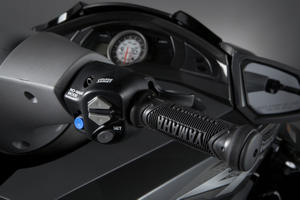 Cruise Assist and No Wake Mode help lessen hand fatigue.
Cruise Assist and No Wake Mode help lessen hand fatigue.That engine brings with it the drive-by-wire throttle goodies Yamaha introduced on the SHO last year. Cruise Assist functions as its name implies. Find a speed you like, hit the button, and Cruise Assist locks you in at the set speed, requiring only you fully squeeze the throttle to keep it active. That allows the driver a full, equal grip on both bars, substantially lessening long-distance fatigue. It also aids in towing wakeboarders and water skiers, who until now, often had to deal with an erratic finger on the throttle. It’s also a welcome feature to the driver, who can now concentrate on the water ahead, rather than constantly watch the speedometer. Cruise Assist locks in the speed, and actually does a pretty good job at holding things steady. Speeds can be bumped up or down by tapping the associated button on the handlebars. To disengage, simply release the throttle.
You’ll also find a No Wake mode. Push the button and the engine locks in around 5 mph, and at this slow speed, requires no hand on the throttle. That makes for easy time spent passing through lengthy no-wake zones.
Familiar Hull
Unchanged is the versatile FX hull. Those keeping track will remember it got an upgrade to Yamaha’s lightweight NanoXcel hull material last year. This year’s engine swap further lightens the load, only increasing the power-to-weight ratio. It’s a workhorse of a hull in the chop, battering its way through the waves in steady, predictable fashion. It’s also stable at rest, allowing driver and passengers to scamper aboard at the dock or launch ramp, or simply take a rest in open water.
The handling is aggressive and relatively precise, but not perfect. At times it can surprise in the corners, biting a little bit more than expected, or feel somewhat loose in straight-line speed runs. The weight shavings let the boat now ride slightly higher in the water than the original design, and I continue to wonder if this plays a large role in the occasional handling quirks that have popped up on the newest models. Still, it’s an overall predictable, secure ride that I often prefer in rougher conditions. Point a Yamaha in the direction you want to go and it gets you there, with no surprises along the way.
The five-position manual trim can fine-tune the ride for weight or water conditions. I like that it allows you to keep your eyes on the water, rather than consult a gauge when things are already happening fast at speed. I don’t like that water exiting the pump fights your control over the trim at high speeds.
Rounding Out The Package…
I feel comfortable sitting and standing aboard the HO, thanks in large part to the adjustable handlebars that can move with you from position to position. There’s about 27 gallons of stowage aboard, split between the voluminous front tub, a deep glovebox that can hold water bottles, a small screw-top canister in the console, and a shallow tray under the furthest aft section of the split seat.
Yamaha’s familiar auto-style security key fob is standard issue, and can activate a slow-speed mode for beginners. That mode can also be used to limit fuel consumption.
Downsides? Reverse is still on the starboard side of the boat, in an awkward position on the console. Yamaha’s lawyers disagree, but I’d argue a portside reverse provides a greater degree of control, as it allows you to both steer and work the throttle as you back up. Yamaha’s simple U-bolt tow eye also seems out of place. It’s functional, certainly, but I’d expect a true ski eye on a boat that costs $11,399.
Still, those gripes are minor in the grand scheme of things. The new power has really awakened the HO’s potential, and the cruise control options are welcome. The HO is a fun, predictable, speedy ride, one that can satisfy the solo carver on morning glass, and handle family duties the rest of the day. The Cruiser ($11,899), meanwhile, adds Yamaha’s deeply sculpted and supportive touring saddle, as well as taller handlebars, a fuel-consumption meter, and nifty pop-up cleats.
Related Reading
2009 Yamaha FX SHO/FX Cruiser SHO Review
2009 Yamaha VX Deluxe/VX Cruiser Review
2009 Yamaha WaveRunner Lineup
Everything Yamaha on PersonalWatercraft.com
Get PersonalWatercraft.com in your Inbox!
Like PersonalWatercraft.com on Facebook
Comments
Most Popular

2025 Yamaha JetBlaster PRO 2-Up Review

2024 Kawasaki Jet Ski STX 160X Review

Remembering the Sea-Doo XP

Whatever Happened to the Wetbike?

2025 Yamaha JetBlaster Review




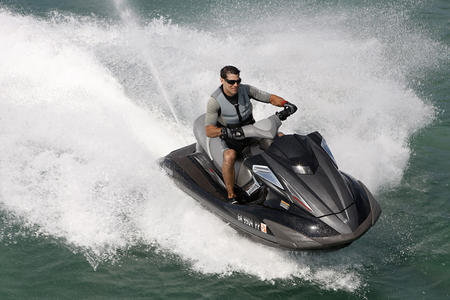
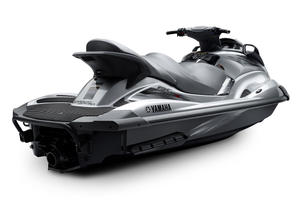
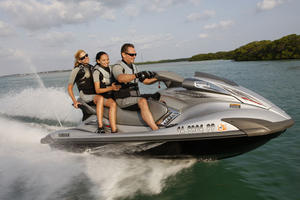
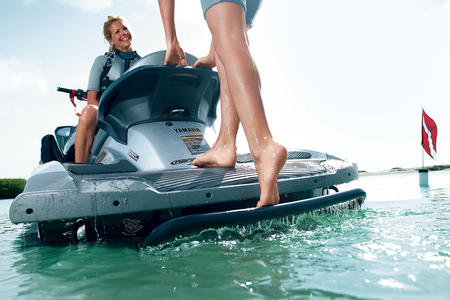







 Your Privacy Choices
Your Privacy Choices